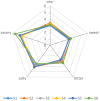Flavor Compounds in Pixian Broad-Bean Paste: Non-Volatile Organic Acids and Amino Acids
- PMID: 29843477
- PMCID: PMC6100464
- DOI: 10.3390/molecules23061299
Flavor Compounds in Pixian Broad-Bean Paste: Non-Volatile Organic Acids and Amino Acids
Abstract
Non-volatile organic acids and amino acids are important flavor compounds in Pixian broad-bean paste, which is a traditional Chinese seasoning product. In this study, non-volatile organic acids, formed in the broad-bean paste due to the metabolism of large molecular compounds, are qualitatively and quantitatively determined by high-performance liquid chromatography (HPLC). Amino acids, mainly produced by hydrolysis of soybean proteins, were determined by the amino acid automatic analyzer. Results indicated that seven common organic acids and eighteen common amino acids were found in six Pixian broad-bean paste samples. The content of citric acid was found to be the highest in each sample, between 4.1 mg/g to 6.3 mg/g, and malic acid were between 2.1 mg/g to 3.6 mg/g ranked as the second. Moreover, fumaric acid was first detected in fermented bean pastes albeit with a low content. For amino acids, savory with lower sour taste including glutamine (Gln), glutamic acid (Glu), aspartic acid (Asp) and asparagines (Asn) were the most abundant, noted to be 6.5 mg/g, 4.0 mg/g, 6.4 mg/g, 4.9 mg/g, 6.2 mg/g and 10.2 mg/g, and bitter taste amino acids followed. More importantly, as important flavor materials in Pixian broad-bean paste, these two groups of substances are expected to be used to evaluate and represent the flavor quality of Pixian broad-bean paste. Moreover, the results revealed that citric acid, glutamic acid, methionine and proline were the most important flavor compounds. These findings are agreat contribution for evaluating the quality and further assessment of Pixian broad-bean paste.
Keywords: HPLC; Pixian broad-bean paste; amino acid; amino acid automatic analyzer; non-volatile organic acid.
Conflict of interest statement
The authors declare that there are no conflicts of interest regarding the publication of this paper.
Figures






Similar articles
-
Effects of salt substitute and Nisin on the flavor development of salt-reduced Pixian douban (broad bean paste).J Food Sci. 2025 Apr;90(4):e70169. doi: 10.1111/1750-3841.70169. J Food Sci. 2025. PMID: 40183984
-
Application effects of NaCl substitute on the fermentation profile of Pixian douban (broad bean paste).J Food Sci. 2024 Apr;89(4):2137-2157. doi: 10.1111/1750-3841.17018. Epub 2024 Mar 11. J Food Sci. 2024. PMID: 38465700
-
Investigation into the potential mechanism of Bacillus amyloliquefaciens in the fermentation of broad bean paste by metabolomics and transcriptomics.Food Res Int. 2024 May;183:114202. doi: 10.1016/j.foodres.2024.114202. Epub 2024 Mar 9. Food Res Int. 2024. PMID: 38760133
-
Bitter Peptides in Fermented Soybean Foods - A Review.Plant Foods Hum Nutr. 2023 Jun;78(2):261-269. doi: 10.1007/s11130-023-01077-3. Epub 2023 Jul 6. Plant Foods Hum Nutr. 2023. PMID: 37410257 Review.
-
Quality characteristics of bean paste as a confectionery ingredient and recent breeding efforts of common beans in Japan.J Sci Food Agric. 2020 Jan 15;100(1):10-15. doi: 10.1002/jsfa.10013. Epub 2019 Oct 13. J Sci Food Agric. 2020. PMID: 31471899 Review.
Cited by
-
The nonvolatile and volatile substances changes based on non-target metabonomics reveals the formation mechanism of Tsamba flavor before and after roasting of highland barley.Food Chem X. 2025 May 3;28:102524. doi: 10.1016/j.fochx.2025.102524. eCollection 2025 May. Food Chem X. 2025. PMID: 40475812 Free PMC article.
-
Effects of Salinity on Physicochemical Properties, Flavor Compounds, and Bacterial Communities in Broad Bean Paste-Meju Fermentation.Foods. 2024 Jul 2;13(13):2108. doi: 10.3390/foods13132108. Foods. 2024. PMID: 38998614 Free PMC article.
-
Phenotypic, Genomic, and Transcriptomic Comparison of Industrial Aspergillus oryzae Used in Chinese and Japanese Soy Sauce: Analysis of Key Proteolytic Enzymes Produced by Koji Molds.Microbiol Spectr. 2023 Feb 6;11(2):e0083622. doi: 10.1128/spectrum.00836-22. Online ahead of print. Microbiol Spectr. 2023. PMID: 36744888 Free PMC article.
-
A method for improving the quality of grass carp (Ctenopharyngodon idellus): A comprehensive evaluation of clear water depuration based on sensory and nutritional aspects.Food Chem X. 2025 May 29;28:102601. doi: 10.1016/j.fochx.2025.102601. eCollection 2025 May. Food Chem X. 2025. PMID: 40520696 Free PMC article.
-
Effects of Dietary Garlic Skin Based on Metabolomics Analysis in the Meat Quality of Black Goats.Foods. 2025 May 28;14(11):1911. doi: 10.3390/foods14111911. Foods. 2025. PMID: 40509439 Free PMC article.
References
-
- Shin Z.I., Yu R., Park S.A., Chung D.K., Ahn C.W., Nam H.S., Kim K.S., Lee H.J. His-His-Leu, and angiotensin I converting enzyme inhibitory peptide derived from Korean soybean paste, exerts antihypertensive activity in vivo. J. Agric. Food Chem. 2001;49:3004–3009. doi: 10.1021/jf001135r. - DOI - PubMed
-
- Zhao J.X., Gu X.H., Liu Y.M., Wang L.P. Study on the Volatile Flavor Compounds of the Traditional Chinese Soybean Paste. Food Sci. 2006;27:684–687.
MeSH terms
Substances
LinkOut - more resources
Full Text Sources
Other Literature Sources

